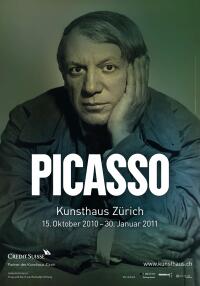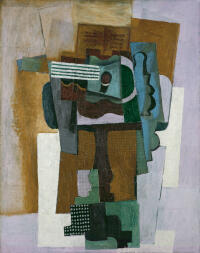Picasso. Die erste Museumsausstellung 1932
15.10.2010 – 30.01.2011
Curated by Tobia Bezzola.
Location Pfister-Bau (Grosser Ausstellungssaal, ehem. Bührlesaal).
Curated by Tobia Bezzola.
Location Pfister-Bau (Grosser Ausstellungssaal, ehem. Bührlesaal).
Picasso, Twice Prominent as a Guest in the Kunsthaus
Why reproduce an exhibition after just under eighty years? Because the 1932 exhibition in the Zurich Kunsthaus showing the then fifty-one-year-old Picasso (1881–1973) had been extraordinary from every point of view. Originally planned as a group show (with Georges Braque and Fernand Léger), it covered works from three decades: the early work, the blue and pink periods, Cubism, Surrealism and Classicism. Most of the works were taken over directly from an exhibition in the Galeries Georges Petit in Paris, but 56 came from the artist’s own collection. Thus, the artist added his own statement in his own way, even if he did not set up the Zurich show in person, as is often claimed, for it was curated by the artist Sigismund Righini together with the Kunsthaus Director, Wilhelm Wartmann.
Although most of the works on show were for sale, few buyers could be found amid the problematic economic crisis. After some back and forth, however, the painting ‘Guitare sur un gueridon’ (1915) was purchased for the Kunsthaus collection, the first purchase of a painting for a public museum in Switzerland. Considering the prevailing conditions, the exhibition also drew a sensationally large public with 34,000 admissions. The fact that the show nevertheless produced a financial deficit, despite a supplementary credit from the city, was hotly debated.
Then as now, Pablo Picasso had the status of a superstar, being called the artist of the century or even a god among artists (Neue Zürcher Zeitung). An artist who was a master of almost everything and whose changing styles and vitality either enthused or deterred his audience. The ‘remake’ in 2010/11 with only seventy paintings and sixty graphic works – in 1932 there had been 225 paintings alone – was very broadly discussed by domestic and foreign media and was also a respectable achievement among the public (130,000 tickets sold). Thus, the Kunsthaus celebrated itself full of confidence – the Moserbau had been opened one hundred years earlier – not only as the biggest art museum in Switzerland by area but also as an institution of the avantgarde. In the accompanying publication the original exhibition was reconstructed in full, and the story of its origins carefully researched.
[Peter Stohler]
Then as now, Pablo Picasso had the status of a superstar, being called the artist of the century or even a god among artists (Neue Zürcher Zeitung). An artist who was a master of almost everything and whose changing styles and vitality either enthused or deterred his audience.
107 days
1 Artist
1 Artist

exhibition poster
Design: HESSKISSSULZERSUTTER AG, Zürich / Photo: Man Ray
Design: HESSKISSSULZERSUTTER AG, Zürich / Photo: Man Ray

